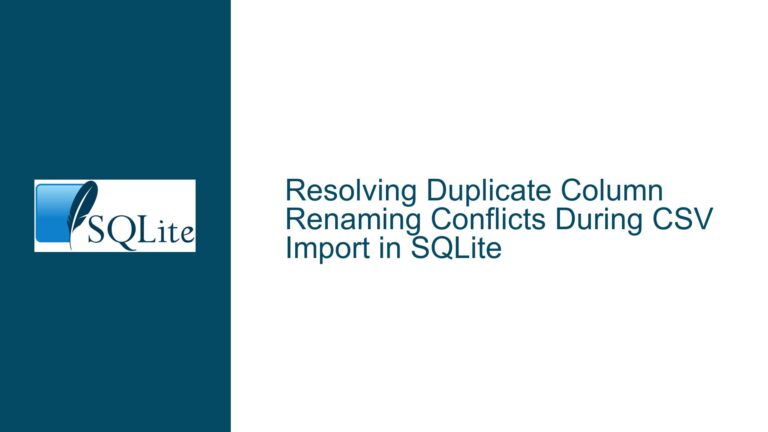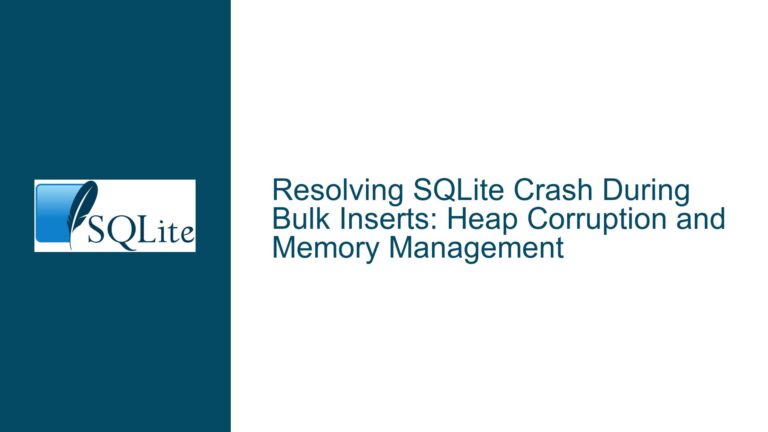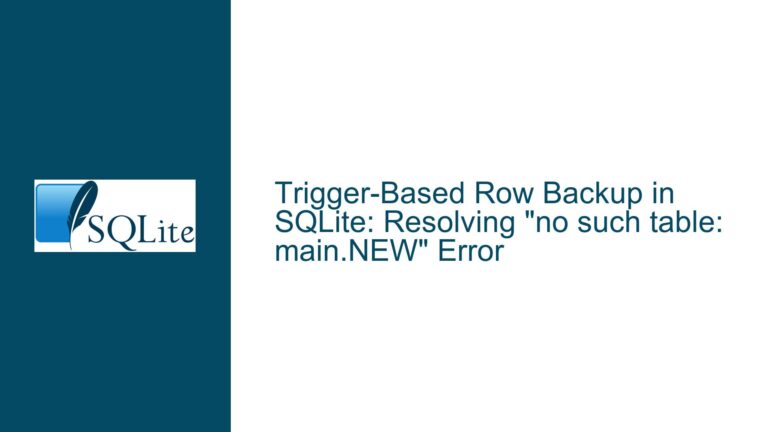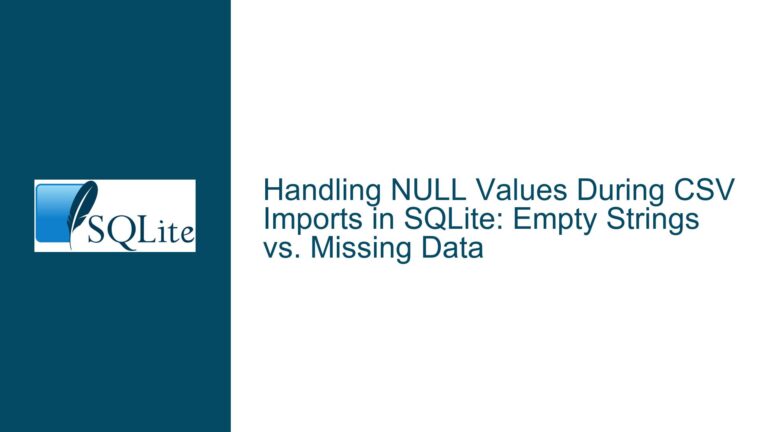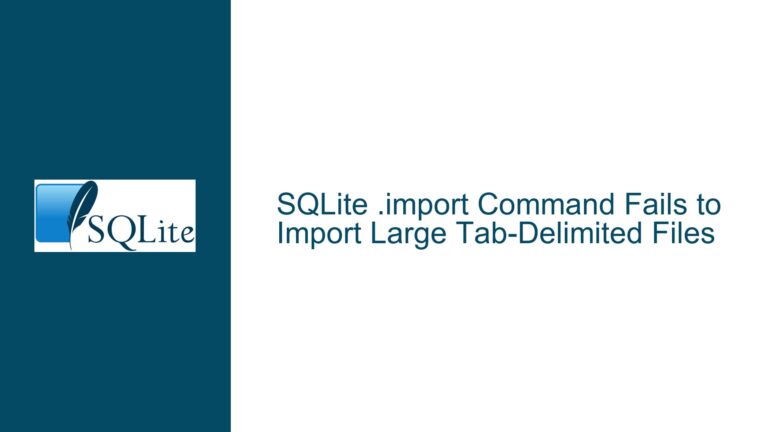Embedded NUL Characters in SQLite Strings: Risks and Mitigation Strategies
The Nature of Undefined Behavior with Embedded NULs in SQLite
SQLite’s handling of strings with embedded NUL (0x00) characters is a nuanced topic rooted in its design and the constraints of the C programming language. The SQLite documentation explicitly states that the result of expressions involving such strings is "undefined," a term that warrants careful interpretation. Unlike undefined behavior in C/C++, which can lead to catastrophic failures like memory corruption or crashes, SQLite’s use of "undefined" in this context refers to inconsistencies in query results rather than low-level instability.
SQLite’s String Handling Internals
SQLite stores TEXT values as C-style strings, which are NUL-terminated by definition. This design choice means that any string containing an embedded NUL character will be implicitly truncated at the first occurrence of 0x00 when processed by SQLite’s internal functions. For example, the string 'A\0B' is treated as 'A' within SQLite’s core operations. This truncation occurs because SQLite relies on standard C library functions like strlen() and strcmp(), which interpret NUL as the end-of-string marker. Consequently, operations such as LENGTH(), SUBSTR(), or comparisons using = or LIKE will behave unpredictably when applied to columns containing embedded NULs.
The Role of the SQLite API
When binding parameters via the SQLite C API (e.g., sqlite3_bind_text()), developers must specify whether the input string is NUL-terminated or if its length is explicitly provided. If a string with an embedded NUL is bound using sqlite3_bind_text() without specifying the correct length, SQLite will truncate the value at the first NUL. However, even when the length is explicitly provided, SQLite’s internal processing of TEXT values remains subject to the limitations of NUL-terminated strings. This creates a disconnect: while the full string (including embedded NULs) can be stored in the database, SQLite’s expression engine will not reliably process it.
Unicode and Embedded NULs
The Unicode standard allows NUL (U+0000) as a valid character, which creates a conflict with SQLite’s C-centric string handling. Applications that accept arbitrary Unicode input might inadvertently introduce embedded NULs into TEXT columns, leading to silent data truncation. For instance, a user-supplied string containing U+0000 followed by additional characters will be stored in full if inserted as a BLOB but truncated if inserted as TEXT. This inconsistency can lead to data integrity issues, especially when applications assume that all Unicode characters are treated uniformly.
Potential Consequences of Embedded NULs in Data Operations
Query Result Inconsistencies
The most immediate impact of embedded NULs is incorrect query results. Consider a table messages with a TEXT column content:
CREATE TABLE messages (id INTEGER PRIMARY KEY, content TEXT);
INSERT INTO messages (content) VALUES (CAST(X'410042' AS TEXT)); -- 'A\0B' in hex
The query SELECT LENGTH(content), content FROM messages; will return 1 and 'A', ignoring the B after the NUL. Similarly, WHERE content = 'A' will match the row, but WHERE content = CAST(X'410042' AS TEXT) will not, despite the stored value technically containing 'A\0B'. Indexes on TEXT columns exacerbate this problem: an index on content will use the truncated value, rendering queries that rely on the full string ineffective.
Data Corruption in Application Layers
While SQLite itself does not crash or corrupt databases due to embedded NULs, application-layer code often assumes that TEXT values are NUL-free. For example, a Python application using sqlite3 might retrieve a value as a string, only to encounter unexpected truncation when passing it to C extensions or file I/O functions. In extreme cases, this could lead to security vulnerabilities, such as improperly validated data bypassing sanitization routines.
Collation and Sorting Ambiguities
Collation sequences that rely on string comparisons will produce undefined results. Suppose a column uses a custom collation that sorts strings case-insensitively. A value 'a\0b' might be sorted relative to 'a' or 'a\0c' unpredictably, as the collation function receives only the truncated string. This behavior undermines data retrieval consistency, particularly in applications requiring precise lexicographical order.
Mitigation Strategies and Best Practices for Handling NULs
Use BLOB for Binary Data
When storing strings that may contain embedded NULs, use the BLOB type instead of TEXT. Unlike TEXT, BLOB columns treat data as raw bytes, preserving all content including NULs. For example:
CREATE TABLE messages (id INTEGER PRIMARY KEY, content BLOB);
INSERT INTO messages (content) VALUES (X'410042'); -- Inserts 'A\0B' as a BLOB
Queries on BLOB columns use byte-wise comparisons, ensuring that X'410042' is distinct from X'41'. Functions like LENGTH() will return the correct byte count, and indexes will behave as expected. Applications must then explicitly handle BLOB-to-string conversions, ensuring that truncation occurs only when intentional.
Input Validation and Sanitization
Applications should validate TEXT inputs to reject embedded NULs unless explicitly allowed. For example, in Python:
def insert_message(conn, content):
if '\x00' in content:
raise ValueError("Embedded NUL characters are not allowed in TEXT columns")
conn.execute("INSERT INTO messages (content) VALUES (?)", (content,))
For cases where NULs are permissible, enforce the use of BLOB columns. Alternatively, sanitize inputs by replacing NULs with a placeholder (e.g., content.replace('\x00', '[NUL]')), though this alters the original data.
Migrating Existing Data
To fix existing databases with truncated TEXT values, migrate affected columns to BLOB:
-- 1. Add a new BLOB column
ALTER TABLE messages ADD COLUMN content_blob BLOB;
-- 2. Copy data from the old TEXT column, preserving NULs
UPDATE messages SET content_blob = CAST(content AS BLOB);
-- 3. Drop the old column and rename the new column
ALTER TABLE messages DROP COLUMN content;
ALTER TABLE messages RENAME COLUMN content_blob TO content;
This process ensures that all data, including previously truncated NULs, is preserved accurately. Applications must then be updated to handle the column as BLOB.
Parameter Binding with Explicit Lengths
When using the C API, always bind strings with embedded NULs using sqlite3_bind_blob() or sqlite3_bind_text() with an explicit length parameter. For example:
const char *data = "A\0B";
int length = 3; // Length includes the NUL and 'B'
sqlite3_bind_text(stmt, 1, data, length, SQLITE_TRANSIENT);
This ensures that the full string is stored, though SQLite’s TEXT processing will still truncate it in expressions. Prefer sqlite3_bind_blob() for binary data.
Application-Level Handling
Applications retrieving TEXT columns that might contain embedded NULs should use byte-based APIs to avoid truncation. For example, in Python:
# Retrieve content as bytes instead of str
cursor.execute("SELECT content FROM messages")
row = cursor.fetchone()
content_bytes = row[0] # Returns bytes if column is BLOB
content_str = content_bytes.decode('utf-8', errors='replace') # Explicit decoding
This approach surfaces embedded NULs early, allowing developers to handle them via error logging or data transformation.
By understanding SQLite’s handling of embedded NULs and adopting strict data typing, input validation, and migration practices, developers can prevent data inconsistencies and ensure robust applications. The key takeaway is to treat TEXT columns as NUL-terminated C strings and BLOB columns as raw byte buffers, choosing the appropriate type based on data requirements.

